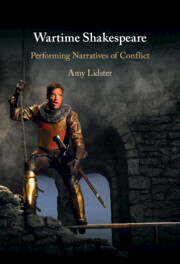Book contents
- Wartime Shakespeare
- Wartime Shakespeare
- Copyright page
- Dedication
- Contents
- Figures
- Acknowledgements
- Note on the Text
- Introduction
- Part I
- Part II
- Chapter 4 Fragmenting Shakespeare(s) and the First World War (1914–18)
- Chapter 5 ‘What We Are Fighting For’
- Chapter 6 ‘Anti-War’ Shakespeare
- Conclusion
- Select Bibliography
- Index
Conclusion
Wartime Shakespeare – ‘A Playable Surface’
from Part II
Published online by Cambridge University Press: 12 October 2023
- Wartime Shakespeare
- Wartime Shakespeare
- Copyright page
- Dedication
- Contents
- Figures
- Acknowledgements
- Note on the Text
- Introduction
- Part I
- Part II
- Chapter 4 Fragmenting Shakespeare(s) and the First World War (1914–18)
- Chapter 5 ‘What We Are Fighting For’
- Chapter 6 ‘Anti-War’ Shakespeare
- Conclusion
- Select Bibliography
- Index
Summary
The conclusion ties together some of the arguments that have recurred throughout this book. Productions of Shakespeare often cast a spotlight on core debates within a conflict, but do not have fixed wartime identities and are, instead, malleable and responsive as a result of their multi-layered networks of production and reception, which is the core methodological framework proposed in this book. It examines the recent use of Hamlet during the Russian invasion of Ukraine in 2022 to reflect on the future of ‘wartime Shakespeare’ and the need for further studies that emphasize the transnational mobilization of Shakespeare that reflects the increasing ‘place-less-ness’ of modern conflict.
- Type
- Chapter
- Information
- Wartime ShakespearePerforming Narratives of Conflict, pp. 276 - 282Publisher: Cambridge University PressPrint publication year: 2023

